In this Issue
- Apple, Pear: codling moth updated spray dates table; woolly apple treat if present
- Peach, Apricot, Plum: peach twig borer treatment dates
- Cherry: western cherry fruit fly treatment starts when fruits turn salmon blush color
- Beneficial Spotlight: minute pirate bug
APPLE, PEAR
Codling Moth
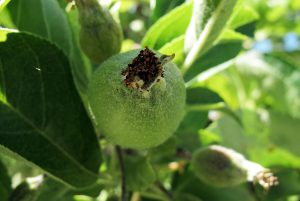
View a pdf of the spray timing table. Be sure to read the instructions at the top of the page, for how to read the table.
Soon, codling moths in most sites will be in the “period of greatest egg hatch.” What this means is that 75% of all eggs for the first generation will be hatching over a 2 to 3 week period. So if you applied a treatment for the start of egg hatch, be sure to re-apply once or twice during the date range shown on the table.
Also during that time period, take some time to inspect your fruit for any codling moth activity. Typically, with the smaller-sized fruit, larvae will enter through the calyx (blossom) end, so you may not be able to tell that there is a “worm” in the apple until it starts pushing out frass (sawdust-like excrement).
Treatment
- See this post for spray options for backyard growers (scroll down to Codling Moth heading and see table).
- Options for commercial growers.
Woolly Apple Aphid
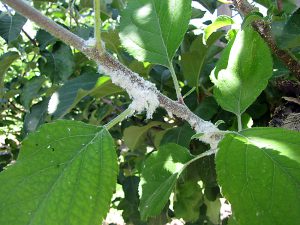
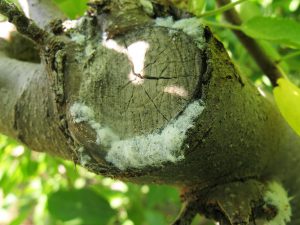
Woolly apple aphids are just starting to show up in the warmer areas of the Wasatch Front. They are first seen where they overwinter in the trees, which is primarily around old pruning cuts. They also overwinter on roots, and some of these stay on roots year-round, while others will migrate up the bark.
Woolly apple aphids are different from typical aphid species in that they feed on twigs, bark and roots, and have a cottony covering on their bodies. We usually do not see these aphids in the trees until mid to late spring.
It is important to scout your own trees to determine when and if a treatment is needed. Start by looking for aphids around the callus wounds of old pruning scars or wounds, and on root suckers.
Treatment
If woollies are a problem every year, it is best to treat them early. Otherwise, treat them when they increase to the point of covering more than 10-20% of the tree.
Because of the aphid’s thick, waxy coating, it is important to spray the tree to drip to reach the aphid bodies.
- Backyard growers can use insecticidal soap+1% oil, aimed directly at the colonies, or Ortho Fruit, Flower, and Vegetable (containing acetamiprid; may have to purchase online).
- Options for commercial growers: click here.
PEACH/NECTARINE, APRICOT, PLUM
Peach Twig Borer
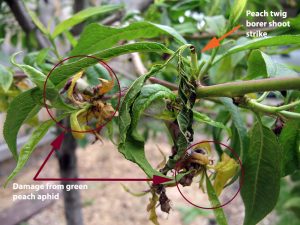
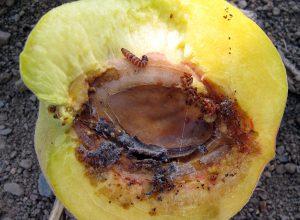
View a pdf of the spray timing table. Be sure to read the instructions at the top of the page, for how to read the table. Due to the continued cold weather, we still only know spray dates for southern Utah and the warmest northern Utah locations.
Peach twig borer is the “worm in the peach”. It is a somewhat sporadic pest in Utah, where some locations have a low enough population that trees do not need to be treated.
Peach twig borer larvae prefer to bore into succulent twigs. Later in the season, when twigs become hardened off and unpalatable, larvae feed inside the fruit.
If peach twig borer is sporadic, you can get away with a single (or no) application for each generation (up to 2 well-timed sprays). Otherwise, one spray is required for first generation, and multiple sprays may be required for second generation (when the fruit is susceptible).
Treatment Options – Backyard Growers
Conventional:
- Ortho Flower, Fruit, and Veg. (acetamiprid; may have to purchase online): Lasts 14 days; softer on beneficial insects
- Sevin, Bonide Fruit Tree Spray (carbaryl): Lasts 14 days
- Spectracide Triazicide (gamma-cyhalothrin): Lasts 14 days
Organic:
- Green Light, Gardens Alive Bull’s Eye, Monterey (spinosad): Lasts 7 days
- Ortho Fruit Spray/Fertilome Fruit Tree Spray (pyrethrin): Lasts 5 days
- Safer BioNEEM (azadirachtin): Lasts 7 to 10 days
Treatment Options – Commercial
- Commercial growers, click here.
CHERRY
Western Cherry Fruit Fly
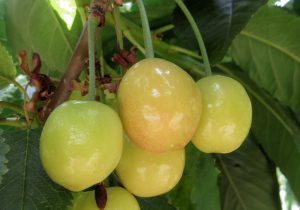
Treatment for western cherry fruit fly—the worms in the fruit—should begin as soon as cherries develop a salmon blush color. Tart cherries in most locations are still green, while sweets are coloring up. It is important to monitor your own trees for color change.
Treatment Options – Backyard Growers
Conventional:
- Malathion (malathion): every 7 days
- Ortho Flower, Fruit, and Veg. (acetamiprid; may have to purchase online): Only the concentrate container includes cherry on the label; apply every 14 days
- Sevin, Bonide Fruit Tree Spray (carbaryl): every 14 days
- Spectracide Triazicide (gamma-cyhalothrin): every 14 days
Organic:
- Fertilome / Gardens Alive / Bull’s Eye / Monterey (spinosad): every 7 days
- Safer BioNEEM (azadirachtin): every 7 to 10 days
Treatment – Commercial Growers
- Commercial growers, click here.
OTHER INFORMATION
Beneficial Spotlight – Minute Pirate Bug
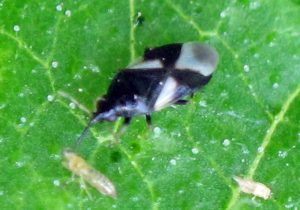
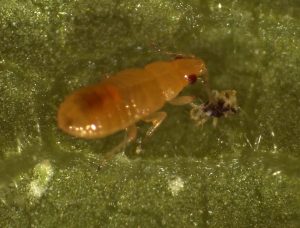
Minute pirate bugs (genus Orius) are one of several true bugs (bigeyed bugs, assassin bugs) that feed on aphids, mites, thrips, small caterpillars, and insect eggs. They are most common in field crops.
This is one of the first predators to appear in spring. Adult minute pirate bugs are small, oval, and black with white markings. Nymphs are pear-shaped and yellowish or reddish brown with red eyes. They are successful predators because the time from egg to adult is very quick–just 3 weeks–and they have many generations per season.
